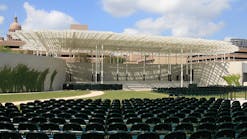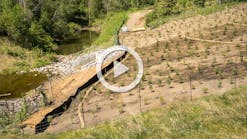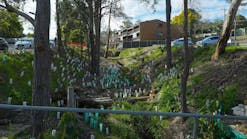Water has washed away soil for millions of years, but it’s meeting its match in today’s erosion control products, including hundreds of rolled erosion control products, or RECPs. From the first, developed in 1973, to the latest environmentally sensitive ones and high-tech turf reinforcement mats (TRMs), there’s an erosion control solution for virtually every problem.
“We see a lot of challenges when it comes to erosion control,” says Jonathan Koepke, manager of the Soil Erosion and Sediment Control Division at ENCAP Inc., an organization of environmental consultants and professionals who specialize in native plantings in Illinois. “The most important considerations when it comes to erosion control blankets are to make sure you select a blanket based on site considerations and the results you want. It’s also important to make sure they’re installed properly.”
Erosion Control Blankets and Mats
The term blanket is usually used for lighter-weight materials and mat for heavier, more permanent ones, but both terms are often used interchangeably. They protect slopes, ditches, landfills, spillways, streams, and shorelines during floods and storms, and they also protect vegetation until it’s well established and can “hold its own.”
They’re usually made of wood excelsior, straw or coir (coconut fiber), or a combination of straw and coir, all of which degrade with exposure to UV rays and the soil. Some are pre-filled with seeds.
Most are held together by nets or meshes of an organic material such as jute or a synthetic one such as polypropylene, which are stitched, woven, or glued together. Some have only one net, some have two; a few “netless” products now on the market have none. Nets of organic material readily degrade, but synthetic ones are more permanent.
Each combination of net and filler has different qualities. Coir and straw blankets are equally flexible, Koepke says. Coir is a bit heavier and tends to have better erosion control characteristics than straw. Straw degrades in about six to 12 months. Coir usually takes about three years to degrade, and the straw/coir combinations, he says, are somewhere in between.
“One of the most important features of straw and coconut blankets is that they provide very good moisture for seeds,” Koepke says. “Prairie species seem to do better with straw and coconut.” As the blankets break down, they provide nutrients for seeds. They also insulate them from heat and cold.
Wood excelsior is made of aspen engineered with knives to create barbs and curls. The barbs cut into the soil and the curls lock together, explains Kurt Kelsey, director of technical services at American Excelsior Co. “When it gets wet, it puffs up, and when it dries, it contracts. It acts like Velcro with the soil.”
The barbs and curls also lock the blankets together, making a true netless blanket possible. Excelsior blankets also maintain moisture and insulate the seeds. They come in a variety of weights, including a new lightweight one, and have a lifespan of between one and three years.
Turf Reinforcement Mats
TRMs are three-dimensional nets (matrices) that hold the soil and establish vegetation by entangling plant roots and stems. They’re made of synthetic fibers such as nylon, polyethylene, PVC, or polyolefin attached together either mechanically or chemically, and they are UV-stabilized and bi-axial (equally strong in both horizontal directions). Some have a lot of open space; others are filled with a degradable material like straw or coir that is stitched or glued to the netting.
TRMs anchor vegetation and allow it to withstand higher volumes and velocities of water than blankets, says Ole Skaar Jr., who’s been an agronomist with the Iowa Department of Transportation’s roadside development department for 24 years. TRMs are especially useful on steeper slopes and in ditches and drainage channels where velocities and shear stresses can wash away both vegetation and soil. They’re often used instead of riprap.
“I think, all around, TRMs are a better system than riprap,” he says. The areas are easier to mow and maintain, they’re safer for the public in case they run off the roads, and there’s no hard armoring that can damage a car. Vegetated channels also allow for better infiltration.
Installation
RECPs come in a variety of widths, and many are pre-marked to show where the staples, stakes, or anchor trenches should be placed. It’s important to follow the recommended pattern and use the right fasteners, Koepke says.
“One of the things in using blankets effectively is putting the right staples down,” he says. “It’s the key to installation.” The choice of fasteners should be based on the site and the final use of the project. Materials include steel wire and wood; there are also cornstarch-based stakes and a “smart plastic” of switch grass oil and corn syrup, which degrade quickly. Fasteners range from 6 to 12 inches in length.
All RECPs should be installed on ground that’s firm, smooth, shaped, and raked, so they can achieve good contact with the soil. They are usually rolled out on top of seed, fertilizer, and topsoil, but they can also be infilled after they’re installed. In both cases vegetation grows through. Seed should match the site conditions.
Applications
When choosing RECPs, the terrain is a main consideration, says Skaar. “I look at the velocity-determined by the grade and the length of the run-and the volume of water. Some of the soils make projects interesting.” Highly erosive soils-such as sandy soils and loess, a fine, silty soil-usually need the extra protection of blankets even on minimum grades.
Climate is also a factor. In the Southeast, says Laurie Honningford, executive director of the Erosion Control Technology Council, blankets that degrade rapidly are useful because vegetation tends to establish rapidly. In harsh, arid, or semi-arid environments, such as the Southwest, vegetation takes longer to establish and needs protection for up to a few years.
Some areas have grass that needs to be mowed soon after installation. Others have wildlife, especially snakes and wetland animals, such as crayfish, that can get tangled in nets, Koepke says. Netless or virtually netless blankets that degrade quickly are very useful in these areas.
The cost of RECPs is based on the type of material and the specialization of the netting, Koepke says. Straw and the new lightweight wood excelsior are generally the least expensive blankets, then straw/coir, and coir, along with other varieties of wood excelsior. The most expensive products are TRMs.
Nettings that degrade the most quickly naturally are usually the least expensive. The ones that are engineered, either to degrade quickly or to be permanent, are the most expensive.
It’s important to match the product to the situation, Honningford says. “”˜One mat fits all’ is a dangerous proposition. You wouldn’t want to overbuild a typical project, but you don’t want to underbuild either.”
The following are some examples of successful applications for the wide variety of RECPs.
Iowa Department of Transportation
Skaar designs plans and specs for an average of six to eight erosion and sediment control projects for the Iowa Department of Transportation (DOT) every year. “We try to go with something that will become vegetated,” Skaar says. “We’ve used three or four types of wood excelsior mats, six to 10 producers of straw mats, and half a dozen turf reinforced mats that meet our specifications.”
He’s used wood excelsior blankets and mats extensively for as long as he’s been with the DOT, in ditches where the grade isn’t too steep and the water volume isn’t too high for vegetation alone to protect the ditch. He uses TRMs or rock when the ditch grades are too steep or the water volume is excessive.
“When the grade is 1 to 2%, and up to 3 to 4%, depending on the length of the ditch and the volume of water, I start looking at wood excelsior,” Skaar says. “If it’s a long ditch, I may have to go down a percentage of grade. At lower velocities, eventually the vegetation will take hold.”
In a project along part of the Mt. Pleasant Bypass on Highway 34, which has a 1 to 3% ditch grade, he used a wood excelsior product down the center of the median ditch and straw blankets on the slopes adjacent to the shoulders. He seeded them with tall fescue, perennial ryegrass, and bird’s-foot trefoil, a seed mixture for areas to be mowed and maintained.
Skaar used Curlex NetFree along a stretch of highway in Ottumwa to evaluate the performance of the blanket in a real-life situation. “I don’t want to rely totally on testing,” he says. “It’s performed well. You have to take a little more care rolling it out.”
When the grade is 6 to 10% and the volume of water may be great enough that the vegetation might not be able to protect the ditch, Skaar uses a TRM. “We started using TRMs in the last five years. We’re using them more and more where we would have used rock to armor the ditch or flume.”
He prefers to roll out the TRMs onto prepared ground first; then infill with soil, seed, and fertilizer; and then cover them with a wood excelsior blanket or mat to keep the soil in place while the vegetation gets established. All blankets and TRMs are watered four times per Iowa DOT specifications.
He still uses the rock where there’s a high-volume water flow and where the use of rock doesn’t present a safety issue. He also uses wood excelsior blankets with straw logs by North American Green and sediment logs by American Excelsior to reduce velocities and settle silt. He’s used GeoRidge and EnviroBerm as well, two synthetic ditch checks made of permeable, high-density plastic. “They could be there for a few years,” he says.Skaar also uses ScourStop, a half-inch-thick, semi-rigid plastic, to protect curb drops and the outlets of culverts from scouring. Holes allow vegetation to grow through. He installs the TRM on top of prepared soil that has been seeded and fertilized, then places ScourStop on top of the TRM. It’s designed to last indefinitely.
“It was used in a project east of Des Moines a year ago,” he says. “It’s been tested with high-volume rains and was very successful.”
Erosion control blankets and mats are invaluable tools in minimizing erosion on slopes and in ditches, Skaar says. “We use them extensively to help revegetate ditches and slopes and, thus, minimize erosion and sediment pollution.”
Town Center Promenade
The developer of the Town Center Promenade in Deer Park, IL, called in ENCAP Inc. after one attempt to stabilize a 1:1 slope had failed, recalls Koepke. The project involved a ravine adjacent to a stream, which had been disturbed for utility construction.
Koepke uses North American Green’s erosion design software to select erosion control mats. For this project he used SC250 TRM, which has a layer of straw and coir between dual layers of polypropylene, for the 75-foot-long slope. “We typically look for blankets with a layer that degrades over time,” he says. “It really takes three years to get a prairie community fully established on a graded slope.”
Crews applied a heavy crop of native seed. Native plants thrive in local conditions and attract native wildlife, but most importantly, from an erosion control point of view, they slow the flow of water and their roots stabilize the soil below the surface.
Because Koepke uses prairie plants that are mowed to 6 or 8 inches high, he won’t have to concern himself with netting getting caught in mower blades. The only problem with natives is that they often germinate more slowly than other plants. In cases where he needs quick cover, Koepke uses fast-germinating annuals like seed oats or annual rye for temporary erosion protection until native species can take over.
Koepke used 12-inch EcoSTAKEs from North American Green for this project because of the steepness of the slope and saturated subsoil conditions. The stakes are made of wood, so they swell when they get wet, he says. Typically, 6-inch stakes work effectively, but he uses the longer ones when there’s a very deep layer of peaty or unconsolidated soil.
The project has worked out well, he says. “Even with heavy rains, it’s established very well.”
Cook County Forest Preserve
Koepke used a different fastener to suit a different final use in a public park, the Cook County Forest Preserve in Palos Park, IL. An ageing toboggan slide with six parallel concrete chutes had been demolished and was replaced with a sledding hill.
He chose a single-net straw blanket from North American Green for the top one-third of the steep, 300-foot slope, and a straw/coir blanket for the steepest two-thirds at the bottom. Because the hill will be used for sledding, he used BioSTAKEs, which are made of fast-degrading cornstarch.
Long Grove
In the Long Grove stream restoration project in Lake County, IL, a developer had removed a dam and the lake that had formed behind it. ENCAP worked with the developer and grading contractor to recreate the relatively narrow stream and used a variety of products to protect it, its floodplain, and its wildlife.
Because the stream is contained in a broad, flat floodplain, there’s never a very high velocity in the channel, Koepke says. Crews placed stones in the streambed, which has soft, silty soil from the lake, to prevent erosion. They used straw/coir BioNet blankets, which are made with biodegradable thread and an open weave, at the shoreline to minimize problems of wildlife getting caught in nets. On the floodplain, they used straw blankets based on where water will have the greatest velocity or flow. All told, they covered about 2 acres with blankets and native plants.
Black Sheep Golf ClubENCAP worked with the developer to control erosion on the slopes of the Black Sheep Golf Club in Sugar Grove, IL. The golf course consists of rolling hillsides, an old glacial mound, constructed ponds, and 115 acres of planting area.
“We chose the blankets according to how susceptible the slopes were to erosion,” Koepke says. The shorelines received North American Green’s double-netted coir matting, which is designed for slopes steeper than 1:1 and for high-flow channels. A large wetland shelf helps to break up ice, so stronger protection for the shear was unnecessary, he says. Crews used a straw/coir blanket above that, then a standard straw blanket on the flatter land.
They planted a series of different prairie species outside the roughs and in the open spaces, he says. “One of the best things we find about straw and coconut is that they give good protection of the investment in native seed,” he says. “For us, the goal has always been to get vegetation established as soon as possible.”
Up to 2 inches of rain per hour can fall in the foothills of Placer County near Sacramento, CA, and slopes can reach 25%, but the county does not allow riprap as erosion control on ditches it maintains.
Winchester Country Club
“We’re required to get vegetation established and not leave the soil bare,” says George Hansen, design engineer with King Engineering in Grass Valley, who’s been working on erosion control design for the Winchester Country Club.
The first phase of the 1,180-acre development, which includes the headwaters of Orr Creek, 409 residential lots, and an 18-hole golf course, began in 1995. The last phase, phase four, is still under construction. Crews have been hydroseeding areas of disturbed soil and slopes, Hansen says, and are using Enkamat from Profile Products along with hydroseeding in the ditches.
Each phase has included a couple of thousand feet of ditches that carry stormwater-sometimes at high velocities-to collection points that drain into wetland preserves on the development, he says. They’re V-shaped and trapezoidal, and typically 1 to 1.5 feet deep. The inlets along the roads are between 200 to 500 feet apart. Where roads run converse to the contours, ditches between some of the lots take the flow to the next road.
“Enkamat can handle high enough velocities and shears,” Hansen says. “You don’t have to change to another product except for a few concrete ditches.” The company specified concrete for ditches that will receive the highest flows, one of them at a 25% grade.
Enkamat is designed to handle shear forces of 10 pounds per square foot, four times the amount that’s typical for the foothills. It consists of a matrix of nylon filaments about 0.75 inches thick. It has more than 95% open space and conforms easily to the ground.
Before crews rolled out the Enkamat, they broadcast a mix of brome, fescue, and clover seed recommended by Natural Resources Conservation Service. “It was mostly fawn fescue for the velocities,” Hansen says. “Fescue does tend to get fairly tall. It’s hard to find erosion control grass that doesn’t grow too tall.”
The mat installs easily, but it’s important to install it carefully, he says. Crews used nails up to 12 inches long with washers where the soil was soft. “You can’t rely on any root foundation initially holding it down. It wants to flutter a little bit.”
If there are rocks in the bottom of a ditch, he adds, it’s crucial to put extra nails around them to keep the mat from tearing and water from getting underneath.
In the fall, crews hydroseeded through the mats. “Hydroseeding puts moisture and cellulose with the seed and glues it down so the seed germinates more successfully,” he explains. “We broadcast the dry seed under the mat for insurance. It may have helped a little bit.”
The project has been successful, he says. There have been some major storms in the area, including a 50-year storm. “It looks like the seed took pretty well. We’ve used that same design [elsewhere] with Enkamat because we felt it did work well.”
Dixon Park District
The Dixon Park District in Dixon, IL, owns and maintains more than 30 parks, a total of 1,130 acres, says Deb Carey, executive director of the Dixon Park District. Many of the parks are along Rock River, a tributary of the Mississippi River. Plum Creek, a tributary of Rock River, flows through one park.
“We have miles and miles of river banks and streambanks,” Carey says, and the terrain on the north shore of the river, which the park district maintains, is a mixture of mud flats and steep clay banks. The banks erode and undercut the trees along the shore, killing them. “We’ve lost so many trees in our parks. For any park district that has river parks, this is an ongoing problem.”
The river floods in the spring and early summer. “In the normal course, the water level changes only about one foot,” Carey says. “But the river can rise and fall dramatically during floods.”
During the Depression, the Civilian Conservation Corps built a limestone sea wall along the river in one of the parks. The sea wall prevents erosion along the shore, Carey says, but it speeds floodwaters downriver. Where there’s no sea wall, the river deposits mud along the shorelines, “which is great because it’s making new mud flats,” she says.
One cause of erosion is the boat ramps, which are used for fishing, boating, and water skiing. Where they cut into the shorelines, the river cuts in and scours out indentations. In one place, the shoreline was so eroded that tree roots were sticking out 3 feet above the river.
The district has tried a number of ways to stabilize the shorelines. In natural areas, it has planted native vegetation, which works well as long as the current is fairly slow, Carey says. It has also used coir fiber netting with some success, but there is often the need for something that will remain stable longer.
It wasn’t until 2000, when the Illinois Department of Natural Resources Ecosystems Program awarded the park district a $35,000 grant, that it finally found a solution to the problem. The Rock River Stabilization Project used Recyclex, a light-duty TRM from American Excelsior Company, and Tri-lock to create a protective barrier against shoreline erosion and provide some habitat for wildlife.
Each pound of Recyclex contains 20 recycled plastic bottles. The mat can be rolled out over ground prepared with grass seed and topsoil, but it is usually installed over bare ground and then filled with soil and seed.
Tri-lock is a system of interlocking concrete blocks. It’s so flexible that it can be installed around trees, Carey says. In spite of the fact that the crew had to wear bathing suits because they were working in the river much of the time, “It’s very easy to install,” she says. “The first time we used it, we hired the company to install it, but now our maintenance crew does it all.”
The project site included 240 feet of shoreline. Crews added clean fill to extend approximately 75 to 80 feet of the bank 3 or 4 feet into the river to cover exposed tree roots, then graded and smoothed an area 25 feet wide, from underwater up the slope and onto level ground. They placed Tri-lock on top of a geotextile in the water and up the bank for 15 feet, then used Recyclex for the remaining 10 feet, placing the Tri-lock over the Recyclex where the two joined. They planted native seeds in the natural areas and Kentucky blue grass in areas that are maintained as lawn.
The district is very happy with the results, Carey says. “We haven’t had any problems. It’s worked especially well on Rock River near our boat ramps in Page Park. Basically, we’re sold on these products for all construction projects, even on fairly level grades.”






